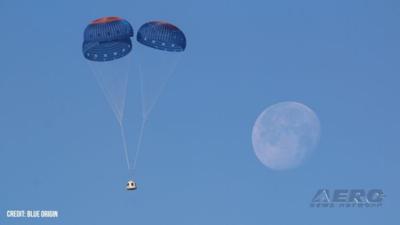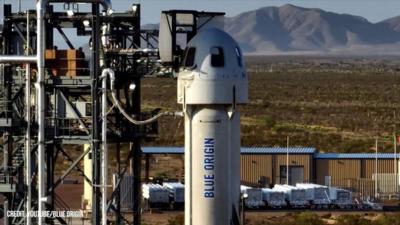September 2022 Mishap Attributed to Failed Engine Nozzle
Blue Origin—the space-launch subsidiary of Amazon boss Jeff Bezos’s business empire—is an impressive outfit with an excellent safety record. The company’s crew-rated suborbital launch vehicle—dubbed New Shepard in homage to American astronaut, moonwalker, Naval Aviator, test-pilot, and bona fide NASA legend Alan Shepard Jr.—has borne satellites, space station supplies, and human beings spaceward over a protracted and unbroken series of safe, successful launches.

Alas, in keeping with the ethos popularized by England’s King Henry II—who famously maintained nothing in life has any business being perfect—a mission-ending anomaly occurred during NS-23, an un-maned flight of Blue Origin’s New Shepard rocket on the morning of 12 September 2022. No lives were lost in the incident, and both Blue Origin and New Shepard—within the context of spaceflight malfunctions—acquitted themselves honorably.
Comes now 24 March 2023, and Blue Origins has made public the findings of the NS-23 investigation. To wit:
- The direct cause of the NS-23 mishap was a thermo-structural failure of the engine nozzle. The resulting thrust misalignment properly triggered the Crew Capsule escape system, which functioned as designed throughout the flight.
- The Crew Capsule and all payloads onboard landed safely and will be flown again.
- All systems designed to protect public safety functioned as planned. There were no injuries. There was no damage to ground-based systems, and all debris was recovered in the designated hazard area.
- Blue Origin expects to return to flight soon, with a re-flight of the NS-23 payloads.
The NS-23 mishap resulted in the loss of NS Propulsion Module Tail 3. The Crew Capsule escape system worked as designed, bringing the capsule and its payloads to a safe landing at Launch Site One with the capsule incurring no damage. As part of the response to the Crew Capsule escape, the Propulsion Module commanded shutdown of the BE-3PM engine and followed an unpowered trajectory to impact within the defined flight safety analysis prediction, resulting in no danger to human life or property. Public safety was unaffected by the mishap, and no changes to crew safety system designs were recommended as a result of the investigation.

In accordance with the New Shepard Mishap Investigation Plan, Blue Origin formed a Mishap Investigation Team (MIT), led by members of Blue Origin’s Safety & Mission Assurance organization. The investigation was conducted with FAA oversight and included representatives of the National Transportation Safety Board and NASA’s Flight Opportunities Program and Commercial Crew Office. The MIT stood up debris search and recovery efforts at Launch Site One immediately following the mishap and recovered all critical flight hardware within days.
Blue Origin also convened a Mishap Review Board (MRB), which included external non-advocate advisors. The MRB reviewed causal determinations made by the MIT and will continue to exercise oversight of the corrective action implementation.
Aided by onboard video and telemetry, flight hardware recovered from the field, and the work of Blue Origin’s materials labs and test facilities, the MIT determined the direct cause of the mishap to be a structural fatigue failure of the BE-3PM engine nozzle during powered flight. The structural fatigue was caused by operational temperatures that exceeded the expected and analyzed values of the nozzle material. Testing of the BE-3PM engine began immediately following the mishap and established that the flight configuration of the nozzle operated at hotter temperatures than previous design configurations. Forensic evaluation of the recovered nozzle fragments also showed clear evidence of thermal damage and hot streaks resulting from increased operating temperatures. The fatigue location on the flight nozzle is aligned with a persistent hot streak identified during the investigation.
The MIT determined that design changes made to the engine’s boundary layer cooling system accounted for an increase in nozzle heating and explained the hot streaks present. Blue Origin is implementing corrective actions, including design changes to the combustion chamber and operating parameters, which have reduced engine nozzle bulk and hot-streak temperatures. Additional design changes to the nozzle have improved structural performance under thermal and dynamic loads.
Blue Origin expects to return to flight soon, with a re-flight of the NS-23 payloads.
The New Shepard spacecraft lifted off from Blue Origin’s West-Texas launch site at approximately 10:26 CDT carrying 36 payloads containing scientific research equipment. One minute and four seconds into the flight, as the vehicle passed through 9,000 meters, the New Shepard capsule's solid rocket motor-powered escape system fired, safely pulling the capsule away from the rocket.
Blue Origin later confirmed that New Shepard had suffered a booster failure, and that the escape system had performed exactly as designed. Had a crew been aboard the capsule, they would have experienced a memorable tumult of racket and high gravitational forces before landing—inauspiciously but unhurt—in the West Texas desert.
Spaceflight aficionados will note with interest that the booster malfunction occurred after New Shepard had passed through max Q, the point along a rocket’s ascent trajectory at which the vehicle is subject to maximum dynamic stresses. Telemetry indicates New Shepard’s BE-3 rocket engine was throttling back up to continue the vessel’s climb to orbit when a large, atypical plume of flame erupted from the engine’s bell.

Notwithstanding sensationalist news reports aggrandizing the perils of spaceflight, the 12 September incident occasioned New Shepard’s first failed mission since the program’s 29 April 2015 inaugural launch—which saw a nominal flight and a safe landing of the vehicle’s capsule, but a loss of its booster section. In the years since New Shepard has made no fewer than twenty consecutive, successful spaceflights and landings—all of which resulted in Mr. Bezos’s capsules and boosters returning safely and soundly to Earth.
Among those twenty launches were six manned missions which saw characters the likes of Jeff Bezos, undersea explorer Victor Vescovo, FAA Inspector and NTSB Investigator Mary “Wally” Funk, and adventurer and Guinness world-record holder Hamish Harding make safe—and very expensive—round-trips to space.
Prior to the 12 September booster hiccup, Blue Origin had completed three successful crewed spaceflights in 2022.
 ANN's Daily Aero-Term (04.24.24): Runway Lead-in Light System
ANN's Daily Aero-Term (04.24.24): Runway Lead-in Light System ANN's Daily Aero-Linx (04.24.24)
ANN's Daily Aero-Linx (04.24.24) Aero-FAQ: Dave Juwel's Aviation Marketing Stories -- ITBOA BNITBOB
Aero-FAQ: Dave Juwel's Aviation Marketing Stories -- ITBOA BNITBOB Classic Aero-TV: Best Seat in The House -- 'Inside' The AeroShell Aerobatic Team
Classic Aero-TV: Best Seat in The House -- 'Inside' The AeroShell Aerobatic Team Airborne Affordable Flyers 04.18.24: CarbonCub UL, Fisher, Affordable Flyer Expo
Airborne Affordable Flyers 04.18.24: CarbonCub UL, Fisher, Affordable Flyer Expo





